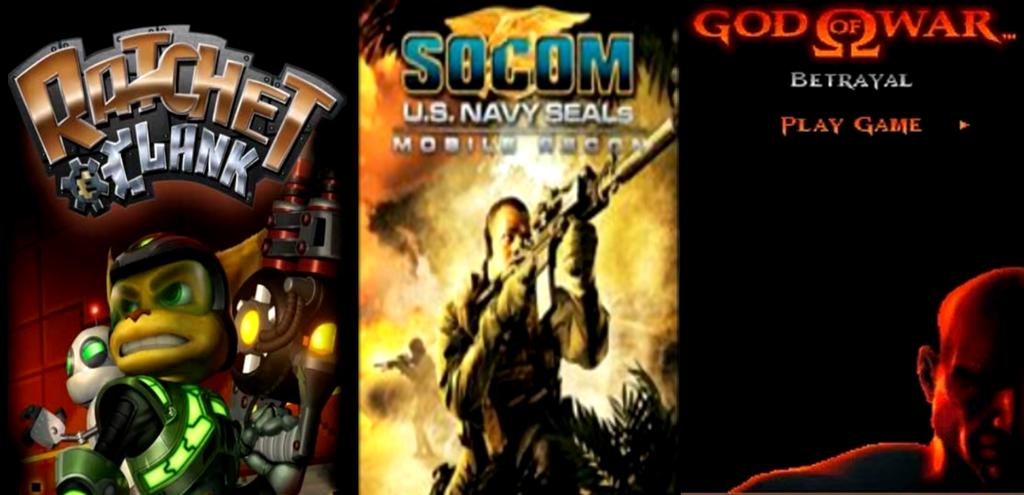Better yet, ensured they were brought over properly, with genuine care and effort, rather than slap-dash clones of other games? Sounds like madness, doesn’t it, but in the early 2000’s, this seriously happened.
- Ratchet & Clank: Going Mobile
Ratchet & Clank: Going Mobile is probably the best well known of the Sony mobile trilogy. Released around the height of Ratchet & Clank‘s PlayStation 2 run, Going Mobile was actually meant to be the first part of a duology, with the latter half cancelled mid-development. This is actually a shame, as while Going Mobile is far from the greatest Ratchet & Clank game, it’s incredibly faithful to the source material. Within minutes of playing, you hear a reference to Secret Agent Clank; you grapple, rail grind, smack, and shoot through an industrial setting inside your phone. Yes, you read that right – Going Mobile is literally set inside your phone, with the titular protagonists pulled inside via a digitizing Macguffin.
[sc name=”quote” text=”It’s never going to outdo its 3D brethren, but as a sidescrolling platformer, Going Mobile was certainly decent for its day.”]
As far as how the game plays, it’s remarkably “okay”. It’s never going to outdo its 3D brethren, but as a sidescrolling platformer, Going Mobile was certainly decent for its day. A handful of the series iconic weapons make the jump, but enemies are a bit on the small side, and the lack of audio for pretty much everything means you’ll be left to fill in the blanks. Still impressive for its day, enough so that parts of it are still loosely considered canon to the series, but overall, more a novelty than anything else.
- SOCOM: Mobile Recon
SOCOM: Mobile Recon by contrast to Ratchet & Clank: Going Mobile opted to eschew its traditional gameplay style – in SOCOM‘s case, hardcore third-person tactical shooting – in favor of a isometric strategy-action hybrid. Though the narrative falls flattest of the bunch thanks to a hackneyed plot about taking down a terrorist organization in Africa, the presentation and level design brings to mind another Sony-favoring franchise: Metal Gear Solid. From codec-call like transmissions from command to the way you navigate every level, it’s not hard to imagine this same gameplay being applied to a handheld entry starring Solid Snake or Big Boss. Shame it doesn’t really exist for anything more than pushing you forward, but that’s least it’s for a good cause.
[sc name=”quote” text=”If anything, SOCOM: Mobile Recon is one of the earliest examples of a studio clearly understanding how to adapt a franchise.”]
Remarkably, Mobile Recon boasts a surprisingly modern array of gameplay features, such as stealth takedowns, issuing squad commands to your AI partner, customizable loadouts before each mission, and a distinctive take on sniping that works far better than it should. It’s far from the depth of say, XCOM, but the fact Mobile Recon actually works as well as it does is a testament to its developers’ skills. If anything, SOCOM: Mobile Recon is one of the earliest examples of a studio clearly understanding how to adapt a franchise to mobile devices, something critical in this industry.
- God of War: Betrayal
God of War: Betrayal rounds out the trilogy on a high note, offering the purest port of the bunch. Set between the events of God of War and God of War II, we get a rare glimpse of protagonist Kratos before his deicide at the hand of his father Zeus, leading the armies of Sparta against their enemies. Despite suffering a similar lack of audio for the majority of its run time, Betrayal does its best with what it can, offering impressively detailed sprites and brutal clashes when you strike down massive mythological monstrosities. Everything’s rendered beautifully with fluid animations as you disembowel anyone and anything that gets in your way.
[sc name=”quote” text=”Despite all the odds stacked against it, God of War: Betrayal is a cut above what you expect from a Java game.”]
Not to be out done, Betrayal also takes full advantage of its vertical camera angle, incorporating it fully into its 2.5D level design, from pointing you towards later objectives to nudging you in the direction of bonus chests full of valuable experience points. This also leads to Betrayal‘s unique take on the God of War series’ wavering appreciation for platforming, trading balancing yourself on wooden beams for more traditional climbing and jumping. You even go toe to toe with Ceryx, son of the deity Hermes, which might not be the same as fighting Poseidon, Hades, or Ares, but Kratos’ bloodlust for conquest rings true all the same. Despite all the odds stacked against it, God of War: Betrayal is a cut above what you expect from a Java game.
[sc name=”quote” text=”As the old saying goes – they don’t make ’em like they used to!”]
While the days of flip phones and Java development may be long gone, it bears wisdom in remembering the accomplishments made before we had smart phones with vivid 3D graphics engines and technology that’s reshaping our world daily. Sony’s been a longstanding provider of mobile phones, and while their handheld gaming systems have fallen out of the spotlight, these three titles were some of the earliest attempts to grow beyond a phone just being a phone. They were all worthwhile efforts, and we reap the benefits of their existence to this very day, so it’s high time we salute the hard work of those who came before. As the old saying goes – they don’t make ’em like they used to!













